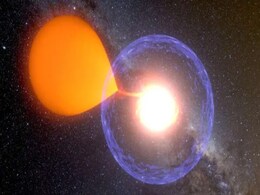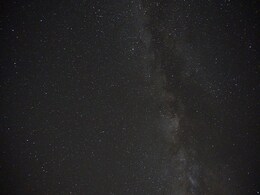Small Magellanic Cloud
- All
- News
-

Our Neighbouring Galaxy Is Being Torn Apart, Scientists Make Shocking Discovery
- Friday April 11, 2025
- Science | Edited by Abhinav Singh
Scientists made the claim after analysing the data collected by the European Space Agency's recently retired Gaia spacecraft.
-
 www.ndtv.com
www.ndtv.com
-

Astronomers Spot New Cosmic Explosions 100 Times Brighter Than the Sun
- Wednesday December 25, 2024
- Written by Gadgets 360 Staff
Astronomers have discovered a new class of cosmic explosions, known as 'millinovas,' which are 100 times brighter than the Sun. These events, first identified in 2023, were observed in the Large and Small Magellanic Clouds, two satellite galaxies of the Milky Way. The millinovas are thought to occur when white dwarfs feed off a companion star, prod...
-
 www.gadgets360.com
www.gadgets360.com
-

James Webb and Chandra Capture Images of Star Clusters in Distant Galaxies
- Thursday December 19, 2024
- Written by Gadgets 360 Staff
NASA’s James Webb Space Telescope and Chandra X-ray Observatory have unveiled stunning new images of two star clusters in the Small Magellanic Cloud. NGC 602, located approximately 200,000 light-years from Earth, showcases active star formation, with dust clouds and ionised gas revealing unique stellar birth conditions. Meanwhile, NGC 2264 featur...
-
 www.gadgets360.com
www.gadgets360.com
-

Webb Telescope Confirms Planet-Forming Disks Last Longer in Early Universe
- Tuesday December 17, 2024
- Written by Gadgets 360 Staff
The James Webb Space Telescope has revealed that planet-forming disks around stars in the early universe lasted far longer than previously believed. By studying NGC 346, a star cluster in the Small Magellanic Cloud, Webb observed disks surviving for 20–30 million years, challenging current models. This discovery suggests that low-metal environmen...
-
 www.gadgets360.com
www.gadgets360.com
-

James Webb Telescope Uncovers First Possible Brown Dwarfs Beyond Milky Way
- Wednesday October 30, 2024
- Written by Gadgets 360 Staff
The James Webb Space Telescope has possibly identified brown dwarfs beyond the Milky Way for the first time, offering new insights into how stars formed in the early universe. Located in the star cluster NGC 602 within the Small Magellanic Cloud, these “failed stars” may help explain star formation under early cosmic conditions. This discovery,...
-
 www.gadgets360.com
www.gadgets360.com
-

Astronomers Successfully Detect Brown Dwarfs in a Distant Star Cluster
- Friday October 25, 2024
- Written by Gadgets 360 Staff
For the first time, astronomers have detected brown dwarfs outside the Milky Way in the star cluster NGC 602, situated approximately 200,000 light-years away in the Small Magellanic Cloud. Utilising the James Webb Space Telescope (JWST), the team sought young brown dwarf candidates in an environment that resembles the early universe, with limited h...
-
 www.gadgets360.com
www.gadgets360.com
-

NASA's Hubble Space Telescope Captures Milky Way's Glittering Neighbour
- Tuesday December 27, 2022
- Feature | Edited by Nikhil Pandey
The data in this image come from two different astronomical investigations which relied on two of Hubble's instruments: the Wide Field Camera 3 (WFC3) and the Advanced Camera for Surveys (ACS).
-
 www.ndtv.com
www.ndtv.com
-

Scientists Use Retired Telescopes to Capture Intricate Images of Cosmic Dust and Clouds
- Saturday June 18, 2022
- Edited by Gadgets 360 Newsdesk
Scientists have captured intricate details of cosmic dust and clouds in space, including the Andromeda galaxy (M31), Triangulum galaxy (M33), and the Large and Small Magellanic Clouds. In order to create images of the cosmic dust and clouds, researchers have relied on data from various retired missions such as the using the European Space Agency (E...
-
 www.gadgets360.com
www.gadgets360.com
-

Small Magellanic Cloud Dying From Gradual Loss of Energy to Form Stars: Study
- Tuesday October 30, 2018
- Indo-Asian News Service
"Galaxies that stop forming stars gradually fade away into oblivion. It's sort of a slow death for a galaxy if it loses all of its gas," said lead researcher Naomi McClure-Griffiths.
-
 www.gadgets360.com
www.gadgets360.com
-

Our Neighbouring Galaxy Is Being Torn Apart, Scientists Make Shocking Discovery
- Friday April 11, 2025
- Science | Edited by Abhinav Singh
Scientists made the claim after analysing the data collected by the European Space Agency's recently retired Gaia spacecraft.
-
 www.ndtv.com
www.ndtv.com
-

Astronomers Spot New Cosmic Explosions 100 Times Brighter Than the Sun
- Wednesday December 25, 2024
- Written by Gadgets 360 Staff
Astronomers have discovered a new class of cosmic explosions, known as 'millinovas,' which are 100 times brighter than the Sun. These events, first identified in 2023, were observed in the Large and Small Magellanic Clouds, two satellite galaxies of the Milky Way. The millinovas are thought to occur when white dwarfs feed off a companion star, prod...
-
 www.gadgets360.com
www.gadgets360.com
-

James Webb and Chandra Capture Images of Star Clusters in Distant Galaxies
- Thursday December 19, 2024
- Written by Gadgets 360 Staff
NASA’s James Webb Space Telescope and Chandra X-ray Observatory have unveiled stunning new images of two star clusters in the Small Magellanic Cloud. NGC 602, located approximately 200,000 light-years from Earth, showcases active star formation, with dust clouds and ionised gas revealing unique stellar birth conditions. Meanwhile, NGC 2264 featur...
-
 www.gadgets360.com
www.gadgets360.com
-

Webb Telescope Confirms Planet-Forming Disks Last Longer in Early Universe
- Tuesday December 17, 2024
- Written by Gadgets 360 Staff
The James Webb Space Telescope has revealed that planet-forming disks around stars in the early universe lasted far longer than previously believed. By studying NGC 346, a star cluster in the Small Magellanic Cloud, Webb observed disks surviving for 20–30 million years, challenging current models. This discovery suggests that low-metal environmen...
-
 www.gadgets360.com
www.gadgets360.com
-

James Webb Telescope Uncovers First Possible Brown Dwarfs Beyond Milky Way
- Wednesday October 30, 2024
- Written by Gadgets 360 Staff
The James Webb Space Telescope has possibly identified brown dwarfs beyond the Milky Way for the first time, offering new insights into how stars formed in the early universe. Located in the star cluster NGC 602 within the Small Magellanic Cloud, these “failed stars” may help explain star formation under early cosmic conditions. This discovery,...
-
 www.gadgets360.com
www.gadgets360.com
-

Astronomers Successfully Detect Brown Dwarfs in a Distant Star Cluster
- Friday October 25, 2024
- Written by Gadgets 360 Staff
For the first time, astronomers have detected brown dwarfs outside the Milky Way in the star cluster NGC 602, situated approximately 200,000 light-years away in the Small Magellanic Cloud. Utilising the James Webb Space Telescope (JWST), the team sought young brown dwarf candidates in an environment that resembles the early universe, with limited h...
-
 www.gadgets360.com
www.gadgets360.com
-

NASA's Hubble Space Telescope Captures Milky Way's Glittering Neighbour
- Tuesday December 27, 2022
- Feature | Edited by Nikhil Pandey
The data in this image come from two different astronomical investigations which relied on two of Hubble's instruments: the Wide Field Camera 3 (WFC3) and the Advanced Camera for Surveys (ACS).
-
 www.ndtv.com
www.ndtv.com
-

Scientists Use Retired Telescopes to Capture Intricate Images of Cosmic Dust and Clouds
- Saturday June 18, 2022
- Edited by Gadgets 360 Newsdesk
Scientists have captured intricate details of cosmic dust and clouds in space, including the Andromeda galaxy (M31), Triangulum galaxy (M33), and the Large and Small Magellanic Clouds. In order to create images of the cosmic dust and clouds, researchers have relied on data from various retired missions such as the using the European Space Agency (E...
-
 www.gadgets360.com
www.gadgets360.com
-

Small Magellanic Cloud Dying From Gradual Loss of Energy to Form Stars: Study
- Tuesday October 30, 2018
- Indo-Asian News Service
"Galaxies that stop forming stars gradually fade away into oblivion. It's sort of a slow death for a galaxy if it loses all of its gas," said lead researcher Naomi McClure-Griffiths.
-
 www.gadgets360.com
www.gadgets360.com










